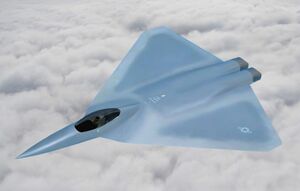لوكهيد مارتن إكس-44 مانتا
| X-44 MANTA | |
|---|---|

| |
| Artist's concept of the X-44 in flight | |
| الدور | Experimental tailless aircraft |
| دولة المنشأ | United States |
| الصانع | Lockheed Martin |
| الوضع | Proposed design, canceled |
| تطورت من | Lockheed Martin F-22 Raptor |
The Lockheed Martin X-44 MANTA (Multi-Axis No-Tail Aircraft) was an American conceptual aircraft design by Lockheed Martin that has been studied by NASA and the U.S. Air Force. It was intended to test the feasibility of full yaw, pitch and roll authority without tailplanes (horizontal or vertical). Attitude control relies purely on 3D thrust vectoring.[1] The aircraft design was derived from the F-22 Raptor and featured a stretched delta wing without tail surfaces.[1]
. . . . . . . . . . . . . . . . . . . . . . . . . . . . . . . . . . . . . . . . . . . . . . . . . . . . . . . . . . . . . . . . . . . . . . . . . . . . . . . . . . . . . . . . . . . . . . . . . . . . . . . . . . . . . . . . . . . . . . . . . . . . . . . . . . . . . . . . . . . . . . . . . . . . . . . . . . . . . . . . . . . . . . . .
History
NASA and the U.S. Air Force had begun preliminary work on the aircraft by May 1999. Plans called for MANTA technologies to be demonstrated on either an F-22 Raptor or F-15. An X-44 prototype would begin test flights by fiscal year 2007. NASA planners stated that developing technologies for the X-44 could have application to the F-22 and Joint Strike Fighter programs and commercial supersonic ventures.[2]
Initial feasibility work was funded by government and two contractors.[2] NASA approved the program to start in June 1999, giving the aircraft the designation "X-44A".[3]
Funding for the X-44 ended in 2000.[4]
Design and development
Planning documents called for an aircraft that "leapfrogs state-of-the-art." The X-44 was designed by Lockheed Martin to demonstrate the feasibility of an aircraft controlled by vectored thrust alone. The X-44 design had a reduced radar signature (due to lack of tail and vertical stabilizers) and was made more efficient by eliminating the tail and rudder surfaces, and instead using thrust vectors to provide yaw, pitch and roll control.[1]
The X-44 MANTA design was based on the F-22. The engine and fuselage would be carried over to the X-44. Major differences included the delta wing shape and tail-less design. Plans called for the elimination of flight control surfaces. Yaw, pitch and roll authority would be accomplished through thrust-vectoring, possibly by modifying the extant 2-D vectoring nozzles of the F-22. These changes would in effect be combining the control and propulsion systems.[2] The X-44 MANTA would have a greater fuel capacity than the F-22, due to its larger delta wing design. The MANTA was designed to have reduced mechanical complexity, increased fuel efficiency and greater agility.[1]
See also
تطورات ذات صلة
References
- ^ أ ب ت ث Jenkins, Dennis R.; Tony Landis; Jay Miller (June 2003). "SP-2003-4531: American X-Vehicles: An Inventory, X-1 to X-50" (PDF). Monographs in Aerospace History, No. 31. NASA. p. 54. Archived from the original on 2020-04-25. Retrieved 2007-10-07.
{{cite web}}: CS1 maint: bot: original URL status unknown (link) - ^ أ ب ت Dupont, Daniel G. (1999). "X-44 MANTA promises to 'leapfrog state-of-the-art': NASA, USAF, F-22 Makers Begin 'Revolutionary' Tailless Aircraft Studies". Inside the Pentagon. Inside Washington Publishers. pp. 1–17. JSTOR 43995403. Retrieved 15 December 2023.
- ^ Dupont, Daniel G. (1999). "F-22A deemed an X-series aerospace vehicle: AIR FORCE, NASA APPROVE START OF X-44A 'TAILLESS' AIRCRAFT STUDIES". Inside the Air Force. Inside Washington Publishers. pp. 1–21. JSTOR 43967782. Retrieved 15 December 2023.
- ^ "X-Planes Explained". NASAExplores.com, 9 October 2003.
- Miller, Jay (2001) [First published 1988]. The X-Planes: X-1 to X-45 (3rd ed.). Hinckley, UK: Midland Publishing. ISBN 9781857801095. OCLC 47726721.
External links
- Day, Dwayne A. "Delta Wings". centennialofflight.net